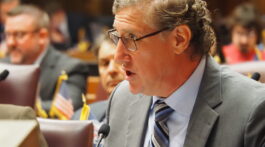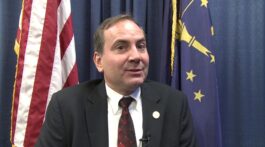by Andrew Weissert
After an election, a common exercise for pollsters is evaluating, ‘How’d we do?’
In late March, Indy Politics conducted a poll of Republican Primary Voters and so we thought we’d revisit some of those findings. A crucial point of emphasis, as always, is that polling is not predictive. It is a snapshot in time. So, our March results would not and could not predict the outcome of the Republican Primary, but I think they turned out to be pretty spot on given how things played out.
First, turnout.
Was this a low-turnout election? If you look at the percentage of overall voters who likely just picked the next governor of Indiana, then sure. Right now, we’re looking at roughly 600,000 Hoosiers casting a ballot in the Republican Primary, or about 15% of total registered voters based on the state’s official count from election reporting.
If we go back to our March poll and analyze primary vote history in our crosstabs, the signs for “low turnout” were certainly there. Aside from high propensity primary voters (those who have voted in 3 or 4 of the last 4 primaries) there are large swaths of indifference among lower propensity voters, saying they might vote or were 50/50. Among those high propensity voters, close to 95% said they would ‘Definitely Vote.’ The ones who always vote, voted. The ones who casually vote, not so much.
It’s important to note, however, that this primary will have had a higher turnout than in 2020, when roughly 525,000 Hoosiers cast their ballot. One reason for successive lower turnouts than say 2016, is that the presidential nomination was already wrapped up. In 2016, Ted Cruz was still making the primary competitive and so you had over a million vote. A competitive presidential primary would’ve motivated more to vote in 2024.
Speaking of the presidential primary, we took an unconventional approach to our ballot in our March poll. We asked:
As you may know, Donald Trump has secured the Republican nomination for president before Indiana Republicans will vote in their primary in May. How will this impact your intention to vote in the Republican primary?
69% said they would still vote for Donald Trump, while 15% said they’d vote for someone else. That might seem like we were slightly off, except here’s what we said.
… if we factor out those who don’t plan to vote in the presidential primary or who are unsure at this point, Trump’s support jumps to 82% among those who will vote on a presidential nominee.
“Those numbers are consistent with the former president’s performances in recent states like Illinois (where he got 81%), Ohio (79%), Florida (81%), Arizona (79%), and Kansas (76%),” says [pollster Andrew] Weissert. “I expect his performance next month to be consistent with how he’s doing around the country.”
82% vs Trump’s actual 78% was within the poll’s margin of error so, we were spot on.
Another point to mention was that our March polling had former President Trump’s favorability at 73%, which lines up closely to where he eventually landed. If you like Trump, you voted for him. If you didn’t (25% Unfavorable), you didn’t (Nikki Haley got 22%).
Next, we polled the Governor’s race.
In our March polling, we had:
- Braun: 33%
- Crouch: 11%
- Doden: 11%
- Chambers: 10%
- Hill: 5%
- Reitenour: 1%
- Undecided: 30%
In the end, Senator Mike Braun won with 40%, while Lt Governor Suzanne Crouch finished in second with 22%. Brad Chambers was third at 18%.
At the time we said:
If you’re trying to detect a trend or read the tea leaves, you should look at self-identifying very conservative voters because they’re the largest ideological voting bloc of the electorate and can quickly swing Republican primaries. Braun is winning them with 39%…
In a low turnout election, it’s the very conservative voters who are the loyal base that dutifully show up.
So, Braun topped out (several polls in the months prior to the election showed little movement up or down for Braun) and the remaining undecided voters disbursed to the other candidates.
From our March polling, among those who would ‘Definity Vote’ Braun lead 33%-Crouch 12%…Doden and Chambers at 10%.
And if you look around the state, our regional crosstabs proved to be accurate also. In Marion Co, we had Braun at 29% with Chambers in second at 15%. Chambers would edge out Braun 30-29%.
In the SW region (including Terre Haute and Evansville DMAs), we had Braun beating Crouch 49% to 17% (she was double the next closest). Braun would ultimately get 43% and Crouch would get 28%.
So, why’d Braun top out? Going back out our March polling analysis, we stated then:
To catch Braun, you’ll need to bring down his ballot and grow your own. With second place a cluster of Crouch, Doden, and Chambers there isn’t a clear alternative to Braun. That’s good for Braun and creates a challenging situation for any of the three to separate themselves from the other two.
For all those Undecided voters, they clearly weren’t sold on Braun, but the other candidates were all generally similar. They were conservative Republicans who agreed on most issues, so that breakthrough never really happened, and Braun coasted to victory.
Crouch’s second place finish – and clear separation from Chambers and Doden – is interesting, however. If we had to make an educated guess, one might look to the current governor, Eric Holcomb. In our March poll, we found 24% of likely Republican primary voters strongly approving of Holcomb’s job performance (65% total job approval). Is it a coincidence his Lt Governor ended up at 22%? Maybe, but another data point supporting that thought is that if you approved of Holcomb’s job performance, Crouch was solidly in second place, ahead of Chambers and Doden.
So, how’d we do? Pretty darn good and we look forward to our next round of polling for the fall general elections.
Andrew Weissert is head of ARW Strategies.













